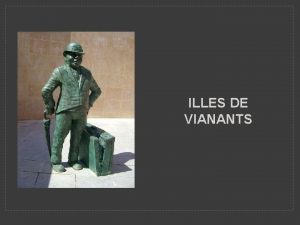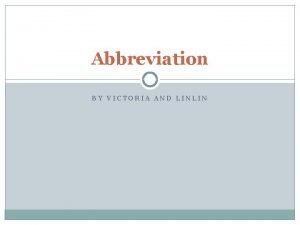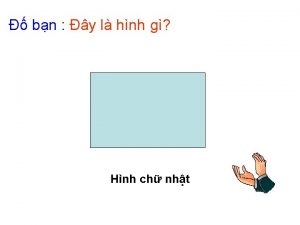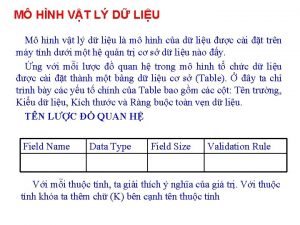S lm vic vn m hnh ha v






















































































































































- Slides: 150

Sự làm việc, vấn đề mô hình hóa và thiết kế của hệ khung-vách chịu cắt • DUCTHUAN 311_TRY TO WIN Asian Center for Engineering Computations and Software, ACECOMS, AIT

Bài toán cơ bản • Bài toán mô hình hoá và phân tích – – Truyền tải trọng cho vách chịu cắt Mô hình hoá vách chịu cắt ở 2 D Mô hình hoá vách chịu cắt ở 3 D Tương tác giữa vách chịu cắt và hệ khung • Bài toán thiết kế và bố trí cốt thép – – Tính toán cốt thép chịu uốn Tính toán cốt thép chịu cắt Bố trí cốt thép ở các lỗ mở và góc Thiết kế và chi tiết liên kết ở các vách chịu cắt dạng ô Shear Wall Behavior, Modeling, Analysis and Design AIT - Thailand ACECOMS

Vách chịu cắt-Một số quan niệm sai lầm § Due to misleading name “Shear Wall” – (lí do do sai lầm trong đặt tên “shear wall”) § The dominant mode of failure is shear § Strength is controlled by shear § Designed is governed primarily by shear § Force distribution can be based on relative stiffness Shear Wall Behavior, Modeling, Analysis and Design AIT - Thailand ACECOMS

Vách chịu cắt hay cột Shear Wall Behavior, Modeling, Analysis and Design AIT - Thailand ACECOMS

Vách chịu cắt hay khung Vách hay khung ? Shear Wall Behavior, Modeling, Analysis and Design Khung AIT - Thailand ACECOMS

Sự làm việc của khung và vách Shear Wall Behavior, Modeling, Analysis and Design AIT - Thailand ACECOMS

Sự làm việc của vách và khung giằng Shear Wall Behavior, Modeling, Analysis and Design AIT - Thailand ACECOMS

Vách và khung Sự làm việc của vách Shear Wall Behavior, Modeling, Analysis and Design Sự làm việc của khung AIT - Thailand ACECOMS

Tương tác giữa khung và vách Shear Wall Behavior, Modeling, Analysis and Design AIT - Thailand ACECOMS

Khung và hệ khung-vách A-1 A-2 A-3 B-4 Shear Wall Behavior, Modeling, Analysis and Design B-1 B-2 B-3 B-4 AIT - Thailand ACECOMS

Tương tác giữa vách và khung • Biến dạng của khung – Biến dạng chủ yếu là biến dạng cắt – Nguồn gốc của độ cứng ngang là độ cứng của nút khung (cột-dầmsàn) • Biến dạng của vách – Biến dạng chủ yếu là uốn – – Biến dạng cắt tương đối nhỏ Chỉ có những vách rất thấp mới bị phá hoại do cắt Làm việc giống như một côn xôn mảnh Được thiết kế để chống lại tác động của cả lực dọc, mômen uốn và lực cắt Shear Wall Behavior, Modeling, Analysis and Design AIT - Thailand ACECOMS

Sự làm việc của vách, khung và hệ khung-vách Shear Wall Behavior, Modeling, Analysis and Design AIT - Thailand ACECOMS

Bài toán Với mỗi toà nhà 10, 20, 30 tầng Chỉ có vách ( 3 trường hợp( Chỉ có khung ( 3 trường hợp( Khung vách ( 3 trường hợp( Tổng 3 x 3 = 9 Trường hợp Shear Wall Behavior, Modeling, Analysis and Design AIT - Thailand ACECOMS

Trường hợp 1 Vách 10 tầng D = 26. 73 cm Chiều dày vách = 15 cm Shear Wall Behavior, Modeling, Analysis and Design AIT - Thailand ACECOMS

Trường hợp 2 Khung 10 tầng D = 15. 97 cm Dầm = 60 cm x 30 cm Cột = 50 cm x 50 cm Shear Wall Behavior, Modeling, Analysis and Design AIT - Thailand ACECOMS

Trường hợp 3 Hệ khung-vách 10 tầng D = 5. 14 cm Dày vách = 15 cm Dầm = 60 cm x 30 cm Cột = 50 cm x 50 cm Shear Wall Behavior, Modeling, Analysis and Design AIT - Thailand ACECOMS

Trường hợp 4 Vách 20 tầng D = 158. 18 cm Dày vách = 20 cm Shear Wall Behavior, Modeling, Analysis and Design AIT - Thailand ACECOMS

Trường hợp 5 Khung 20 tầng D = 27. 35 cm Dầm = 60 cm x 30 cm Cột = 75 cm x 75 cm Shear Wall Behavior, Modeling, Analysis and Design AIT - Thailand ACECOMS

Trường hợp 6 Khung-vách 20 tầng D = 12. 66 cm Dày vách = 20 cm Dầm = 60 cm x 30 cm Cột = 75 cm x 75 cm Shear Wall Behavior, Modeling, Analysis and Design AIT - Thailand ACECOMS

Trường hợp 7 Vách 30 tầng D = 355. 04 cm Dày vách = 30 cm Shear Wall Behavior, Modeling, Analysis and Design AIT - Thailand ACECOMS

Trường hợp 8 Khung 30 tầng D = 40. 79 cm Dầm = 60 cm x 30 cm Cột = 100 cm x 100 cm Shear Wall Behavior, Modeling, Analysis and Design AIT - Thailand ACECOMS

Trường hợp 9 Khung-vách 30 tầng D = 20. 87 cm Dày vách = 30 cm Dầm = 60 cm x 30 cm Cột = 100 cm x 100 cm Shear Wall Behavior, Modeling, Analysis and Design AIT - Thailand ACECOMS

Tương tác khung-vách Shear Wall Behavior, Modeling, Analysis and Design AIT - Thailand ACECOMS

Tương tác khung-vách Shear Wall Behavior, Modeling, Analysis and Design AIT - Thailand ACECOMS

Tương tác khung-vách Shear Wall Behavior, Modeling, Analysis and Design AIT - Thailand ACECOMS

Tương tác khung-vách Shear Wall Behavior, Modeling, Analysis and Design AIT - Thailand ACECOMS

Tương tác khung-vách D = Lực / Độ cứng = Lực / D Với bài toán ở đây (ví dụ 30 tầng : ( Độ cứng Khung = 200 / 40. 79 = 04. 90 Lực=200 Chuyển vị = 40. 79 Độ cứng Vách = 200 / 355. 04 = 00. 56 Độ cứng Khung-vách = 200 / 12. 66 = 15. 79 Độ cứng Khung +Độ cứng Vách = 4. 90 + 0. 56 = 5. 46 Độ cứng Khung +Độ cứng Vách Độ cứng Khung-vách Shear Wall Behavior, Modeling, Analysis and Design AIT - Thailand ACECOMS

Change in Shear Wall Moments for the Coupled System Shear Wall Behavior, Modeling, Analysis and Design AIT - Thailand ACECOMS

Coupling Element Moments Shear Wall Behavior, Modeling, Analysis and Design AIT - Thailand ACECOMS

Shear Wall-Frame Load Distribution Curves Shear Wall Behavior, Modeling, Analysis and Design AIT - Thailand ACECOMS

Deflected Shape of Shear Wall-Frame Interactive System Khan-Sbarounis Curves Shear Wall Behavior, Modeling, Analysis and Design AIT - Thailand ACECOMS

Comparison of Shears and Moments in the Core wall 4 Different Layouts for Same Function Requirements Type A Type C Shear Wall Behavior, Modeling, Analysis and Design Type B Type D AIT - Thailand ACECOMS

Comparison of… : Type A Typical Floor Plan- Structure Type A Shear Wall Behavior, Modeling, Analysis and Design AIT - Thailand ACECOMS

Comparison of… : Type B Typical Floor Plan- Structure Type B Shear Wall Behavior, Modeling, Analysis and Design AIT - Thailand ACECOMS

Comparison of… : Type C Typical Floor Plan- Structure Type C Shear Wall Behavior, Modeling, Analysis and Design AIT - Thailand ACECOMS

Comparison of… : Type D Typical Floor Plan- Structure Type D Shear Wall Behavior, Modeling, Analysis and Design AIT - Thailand ACECOMS

Comparison of Shears and Moments in the Core wall Shear Wall Behavior, Modeling, Analysis and Design AIT - Thailand ACECOMS

Tương tác khung-vách-Kết luận – Vách biến dạng chủ yếu do uốn – Giả thuyết phổ biến bỏ qua khả năng chịu lực ngang của khung có thể dẫn đến những sai số rất lớn – Việc đánh giá đúng tương tác khung-vách có thể làm cho việc thiết kế kinh tế hơn – Vách được thiết kế để chống lại tác động của lực dọc, momen uốn, và lực cắt – Việc bố trí vách trên mặt bằng rất quan trọng Shear Wall Behavior, Modeling, Analysis and Design AIT - Thailand ACECOMS

Các dạng cơ bản của vách Shear Wall Behavior, Modeling, Analysis and Design AIT - Thailand ACECOMS

Các dạng cơ bản của vách Shear Wall Behavior, Modeling, Analysis and Design AIT - Thailand ACECOMS

Các tuỳ chọn cho việc mô hình hoá vách cứng

Sử dụng cấu kiện 1 D Dầm đơn giản với nút cứng Dầm đơn giản Dầm dạng “dàn” H 2 H 1 t t L Shear Wall Behavior, Modeling, Analysis and Design txh L L AIT - Thailand ACECOMS

Mô hình khung cho vách phẳng H t B • Đặc biệt thích hợp cho H/B lớn hơn 5 • Thay thế vách bằng một “cột” có tiết diện “B x t” • Các dầm bên ngoài mép vách xem như dầm thông thường • “Cột” được liên kết với dầm qua vùng cứng hay có tiết diện ngang rất lớn Vùng cứng Shear Wall Behavior, Modeling, Analysis and Design AIT - Thailand ACECOMS

Mô hình khung cho lõi t H B 2 t H t B • Rất khó để mở rộng khái niệm vách không phẳng • Lõi phải được chuyển thành cột “tương đương” và phần tử cứng phù hợp • Có thể sử dụng trong phân tích 2 D và 3 D (phức tạp hơn) • Sau khi lõi được chuyển thành vách phẳng, có thể sử dụng phương pháp đơn giản hơn để mô hình hoá Shear Wall Behavior, Modeling, Analysis and Design AIT - Thailand ACECOMS

Mô hình hoá vách bằng phần tử 2 D • Walls are subjected to in-plane deformations so 2 D elements that have transnational DOF need to be used • A coarse mesh can be used to capture the overall stiffness and deformation of the wall • A fine mesh should be used to capture in-plane bending or curvature • General Shell Element or Membrane Elements can be used to model Shear Walls Shear Wall Behavior, Modeling, Analysis and Design AIT - Thailand ACECOMS

Modeling Walls Using Membrane The Incomplete Membrane Element Nodes: 4 DOFs: 2 DOFs /Node Ux and Uy 2 -Translation Dimension: 2 dimension element Shape: Regular / Irregular Properties: Modulus of Elasticity(E), Poisson ratio(v), Thickness( t ) This “Incomplete” Panel or Membrane Element does not connect with Beams completely and rotation DOF of beams and the ends are “Orphaned” Shear Wall Behavior, Modeling, Analysis and Design AIT - Thailand ACECOMS

Modeling Walls using Shell Elements The Complete Membrane Element Nodes: 4 DOFs: 3 DOFs /Node Ux and Uy and Rz 2 Translation, 1 rotation Dimension: 2 dimension element Shape: Regular / Irregular Properties: Modulus of Elasticity(E), Poisson ratio(v), Thickness( t ) Shear Wall Behavior, Modeling, Analysis and Design AIT - Thailand ACECOMS

Using Incomplete Membrane Elements Multiple elements greater accuracy in determination of stress distribution and allow easy modeling of openings Using Incomplete Membrane only Using with Beams and or Columns are Required (No Moment continuity with Beams) (Full Moment continuity with Beams and Columns) Shear Wall Behavior, Modeling, Analysis and Design AIT - Thailand ACECOMS

Using Complete Membrane Elements Multiple elements greater accuracy in determination of stress distribution and allow easy modeling of openings Using Complete Membrane only Using with Beams, Columns is NOT Required (Moment continuity with Beams automatically provided) (Full Moment continuity with Beams and Columns) Shear Wall Behavior, Modeling, Analysis and Design AIT - Thailand ACECOMS

Connecting Walls to Slab “Zipper” In general the mesh in the slab should match with mesh in the wall to establish connection Shear Wall Behavior, Modeling, Analysis and Design Some software automatically establishes connectivity by using constraints or “Zipper” elements AIT - Thailand ACECOMS

Using Trusses to Model Shear Walls • The behavior of shear walls can be closely approximated by truss models: – The vertical elements provide the axial-flexural resistance – The diagonal elements provide the shear resistance • Truss models are derived from the “strut-tie” concepts • This model represents the “cracked” state of the wall where all tension is taken by ties and compression by concrete Shear Wall Behavior, Modeling, Analysis and Design AIT - Thailand ACECOMS

Truss Model for Shear Walls 10 Comparing Deformation and Deflections of Shell Model with Truss Model 5 2 Shear Wall Behavior, Modeling, Analysis and Design AIT - Thailand ACECOMS

Truss Model for Shear Walls 10 Comparing Deformation and Deflections of Shell Model with Truss Model 5 2 Shear Wall Behavior, Modeling, Analysis and Design AIT - Thailand ACECOMS

Truss Models for Shear Walls 10 Comparing Axial Stress and Axial Force Patterns 5 2 Shear Wall Behavior, Modeling, Analysis and Design AIT - Thailand ACECOMS

Truss Models for Shear Walls 10 5 2 Uniaxial Shear Wall Behavior, Modeling, Analysis and Design Biaxial AIT - Thailand ACECOMS

How to Construct Truss Models txt C t x 2 t B • For the purpose of analysis, assume the main truss layout based on wall width and floor levels • Initial member sizes can be estimated as t x 2 t for main axial members and t x t for diagonal members • Use frame elements to model the truss. It is not necessary to use truss elements • Generally single diagonal is sufficient for modeling but double diagonal may be used for easier interpretation of results • The floor beams and slabs can be connected directly to truss elements t Shear Wall Behavior, Modeling, Analysis and Design AIT - Thailand ACECOMS

Openings in Shear Walls Very Small Openings may not alter wall behavior Medium Openings may convert shear wall to Pier and Spandrel System Very Large Openings may convert the Wall to Frame Beam Spandrel Column Wall Pier Shear Wall Behavior, Modeling, Analysis and Design Pier AIT - Thailand ACECOMS

Openings in Shear Walls - Cellular 5 2 Shear Wall Behavior, Modeling, Analysis and Design AIT - Thailand ACECOMS

Openings in Shear Walls - Planer Shear Wall Behavior, Modeling, Analysis and Design AIT - Thailand ACECOMS

Modeling Walls with Opening Plate-Shell Model Shear Wall Behavior, Modeling, Analysis and Design Rigid Frame Model Truss Model AIT - Thailand ACECOMS

Frame Model of Shear Walls Based on Concept proposed by E. L. Wilson Shear Wall Behavior, Modeling, Analysis and Design AIT - Thailand ACECOMS

Using Beam-Column to Model Shear Walls – 4 -Node plane element may not accurately capture the linear bending, because constant shear distribution is assumed in formulation but actually shear stress distribution is parabolic – Since the basic philosophy of RC design is based on cracked sections, it is not possible to use the finite elements results directly for design – Very simple model (beam-column) which can also captures the behavior of the structure, The results can be used directly to design the concrete elements. Shear Wall Behavior, Modeling, Analysis and Design AIT - Thailand ACECOMS

Shear Wall Design –Meshing • Shell Deformations: – Three types of deformation that a single shell element could experience – A single shell element in the program captures shear and axial deformations well. – But a single shell element is unable to capture bending deformation. Shear Wall Behavior, Modeling, Analysis and Design AIT - Thailand ACECOMS

Modeling Shear Walls Using Shell Elements A-1 Plates with Columns and Beams A-2 Plates with Beams Shear Wall Behavior, Modeling, Analysis and Design A-3 Plates with Columns A-4 Plates Only AIT - Thailand ACECOMS

Modeling Shear Walls Using Beam Elements B-1 Single Bracing B-2 Double Bracing Shear Wall Behavior, Modeling, Analysis and Design B-3 Column with Rigid Zones B-4 Columns with Flexible Zones AIT - Thailand ACECOMS

Comparison of Behavior A-1 A-2 A-3 B-4 Shear Wall Behavior, Modeling, Analysis and Design B-1 B-2 B-3 B-4 AIT - Thailand ACECOMS

Comparison of Behavior (5 Floors) B 4 A 1 B 1 B 4 Shear Wall Behavior, Modeling, Analysis and Design AIT - Thailand ACECOMS

Comparison of Behavior (15 Floors) B 4 A 1 B 1 B 4 Shear Wall Behavior, Modeling, Analysis and Design AIT - Thailand ACECOMS

Comparison of Behavior (25 Floors) B 4 A 1 B 1 B 4 Shear Wall Behavior, Modeling, Analysis and Design AIT - Thailand ACECOMS

Effect of Shear Wall Location Shear Wall Behavior, Modeling, Analysis and Design AIT - Thailand ACECOMS

Modeling of Shear Walls In ETABS Shear Wall Behavior, Modeling, Analysis and Design AIT - Thailand ACECOMS

Shear Wall Design – Using ETABS Special Considerations/Concepts: – Zoning • • • – Pier Spandrel and Boundary Zone Labeling • • – Pier Spandrel Section Types • • • Simplified Section (C, T or Linear) Uniform reinforcing section General Sections Shear Wall Behavior, Modeling, Analysis and Design AIT - Thailand ACECOMS

Shear Wall Design –Meshing • Wall Meshing and Load Transfer: – – Appropriate Meshing and labeling of Shear Walls is the key to proper modeling and design of walls No automatic meshing is available for walls (only manual) Loads are only transferred to walls at the corner points of the area objects that make up the wall Generally the Membrane or Shell type Elements should be used to model walls Shear Wall Behavior, Modeling, Analysis and Design AIT - Thailand ACECOMS

Shear Wall Design –Meshing Wall Meshing: – Piers and spandrels where bending deformations are significant (slender piers and spandrels), need to mesh the pier or spandrel into several elements – If the aspect ratio of a pier or spandrel one shell element is worse than 3 to 1, consider additional meshing of the element to adequately capture the bending deformation Shear Wall Behavior, Modeling, Analysis and Design AIT - Thailand ACECOMS

Shear Wall Design – Pier Zones Pier Zone Labeling (Naming/Grouping) – Pier labels are assigned to vertical area objects (walls) and to vertical line objects (columns) – Objects that are associated with the same story level and have the same pier label are considered to be part of the same pier. – Must assign a pier element a label before you can get output forces for the element or before you can design the element. Shear Wall Behavior, Modeling, Analysis and Design AIT - Thailand ACECOMS

Shear Wall Design – Pier Zones – A single wall pier cannot extend over multiple stories – Wall pier forces are output at the top and bottom of wall pier elements – Wall pier design is only performed at stations located at the top and bottom of wall pier elements. Shear Wall Behavior, Modeling, Analysis and Design AIT - Thailand ACECOMS

Shear Wall Design – Pier Zones Piers Labeling Examples Shear Wall Behavior, Modeling, Analysis and Design AIT - Thailand ACECOMS

Shear Wall Design – Pier Zones General Comments on Case d: – – All of the area objects given the same label P 1 Design is performed across the entire wall at each story level Wall forces would be provided for the entire wall at each story level Combined reinforcement is reported at the top and bottom of each floor (3 -5 area objects) Section for Design at II Floor Top Shear Wall Behavior, Modeling, Analysis and Design AIT - Thailand ACECOMS

Shear Wall Design – Pier Zones General Comments on Case a: – – – – Common way to label piers At the upper level, Pier P 1 is defined to extend all the way across the wall above the openings. Pier P 2 makes up the wall pier to the left of the door opening. Pier P 3 occurs between the door and window openings. Pier P 4 occurs between the window opening and the edge of the wall. Pier P 5 occurs below the window opening between the door and the edge of the wall. A similar labeling of piers occurs at the lower level. Shear Wall Behavior, Modeling, Analysis and Design AIT - Thailand ACECOMS

Shear Wall Design – Pier Zones General Comments on Case a (Common Way): – – – At the upper level, Pier P 1 is defined to extend all the way across the wall above the openings. Pier P 2 makes up the wall pier to the left of the door opening. Pier P 3 occurs between the door and window openings. Pier P 4 occurs between the window opening and the edge of the wall. Pier P 5 occurs below the window opening between the door and the edge of the wall. A similar labeling of piers occurs at the lower level. Shear Wall Behavior, Modeling, Analysis and Design AIT - Thailand ACECOMS

Shear Wall Design – Pier Zones General Comments on Case a (Common Way): Design pier – 1 Design pier – 2 Design pier – 3 Sections Design pier – 4 Output for Each Pier Shear Wall Behavior, Modeling, Analysis and Design AIT - Thailand ACECOMS

Shear Wall Design – Spandrel Zones Spandrel Zone Labeling (Naming/Grouping) – Spandrel labels are assigned to vertical area objects (walls) and to horizontal line objects (beams) – Unlike pier elements, a single wall spandrel element can be made up of objects from two (or more) adjacent story levels – Must assign a spandrel element a label before you can get output forces for the element or before you can design the element Shear Wall Behavior, Modeling, Analysis and Design AIT - Thailand ACECOMS

Shear Wall Design – Pier Zones Shear Wall Behavior, Modeling, Analysis and Design AIT - Thailand ACECOMS

Shear Wall Design – Spandrel Zones Spandrels or Headers – Wall spandrel forces are output at the left and right ends of wall spandrel Elements – Wall spandrel design is only performed at stations located at the left and right ends of wall spandrel elements – Multiple wall spandrel labels cannot be assigned to a single area object. Shear Wall Behavior, Modeling, Analysis and Design AIT - Thailand ACECOMS

Shear Wall Design – Spandrel Zones Examples: Spandrel Labeling Shear Wall Behavior, Modeling, Analysis and Design AIT - Thailand ACECOMS

Concrete Shear Wall Design • Fully integrated wall pier and spandrel design • ACI, UBC and Canadian Codes • Design for static and dynamic loads • Automatic integration of forces for piers and spandrel Shear Wall Behavior, Modeling, Analysis and Design AIT - Thailand ACECOMS

Shear Wall Design • Design based on : – Equilibrium Conditions – Strain Compatibility Principle – Linear Strain Variation Shear Wall Behavior, Modeling, Analysis and Design AIT - Thailand ACECOMS

Interaction Surface for Shear Walls P My Mx Shear Wall Behavior, Modeling, Analysis and Design AIT - Thailand ACECOMS

Concrete Shear Wall Design • • 2 D wall pier design and boundary-member checks 2 D wall spandrel design 3 D wall pier check for provided reinforcement Graphical Section Designer for concrete rebar location Graphical display of reinforcement and stress ratios Interactive design and review Summary and detailed reports including database formats Shear Wall Behavior, Modeling, Analysis and Design AIT - Thailand ACECOMS

Shear Wall - Typical Design Process 1. While modeling define Shear Wall elements 2. Choose the Shear Wall design code and review other related preferences and revise them if necessary 3. Assign pier and spandrel labels 3. Run the building analysis 4. Assign overwrites 5. Select Design Combos 6. Start Designing Walls Shear Wall Behavior, Modeling, Analysis and Design AIT - Thailand ACECOMS

Shear Wall - Typical Design Process 7. View Design Input and Output Information 8. Design the Member Interactively 9. Print Design Report 10. Change Design Section if Required 11. Re-run Design and Re-analyze if needed 12. Repeat the Above Cycle Shear Wall Behavior, Modeling, Analysis and Design AIT - Thailand ACECOMS

Shear Wall Design – Output Shear Wall Behavior, Modeling, Analysis and Design AIT - Thailand ACECOMS

Shear Wall Design – Output Shear Wall Behavior, Modeling, Analysis and Design AIT - Thailand ACECOMS

Shear Wall Design – Output Shear Wall Behavior, Modeling, Analysis and Design AIT - Thailand ACECOMS

Shear Wall Design – Output Shear Wall Behavior, Modeling, Analysis and Design AIT - Thailand ACECOMS

The Basic Issues • What is a Shear Wall? • Modeling and analysis issues – – Transfer of loads to shear walls Modeling of shear walls in 2 D Modeling of shear Walls in 3 D Interaction of shear-walls with frames • Design and detaining issues – – Determination of rebars for flexure Determination of rebars for shear Detailing of rebars near openings and corners Design and detailing of connection between various components of cellular shear walls Shear Wall Behavior, Modeling, Analysis and Design AIT - Thailand ACECOMS

Avoid Eccentricity in Plan Or Shear Wall Behavior, Modeling, Analysis and Design AIT - Thailand ACECOMS

Reduce In-plane Bending in Floor Shear Wall Behavior, Modeling, Analysis and Design AIT - Thailand ACECOMS

Vertical Irregularity Expansion Joint No Shear Walls Balanced Shear Walls at All Levels Shear Wall Behavior, Modeling, Analysis and Design Using Expansion Joints to eliminate some walls AIT - Thailand ACECOMS

Using Efficient Building Plan Shape Shear Wall Behavior, Modeling, Analysis and Design AIT - Thailand ACECOMS

Design of Shear Walls

Axial Stresses in Planer Walls 10 5 2 Shear Wall Behavior, Modeling, Analysis and Design AIT - Thailand ACECOMS

Axial Stresses in Cellular Walls 10 Uniaxial Bending 5 2 Shear Wall Behavior, Modeling, Analysis and Design AIT - Thailand ACECOMS

Axial Stresses in Cellular Walls 10 Biaxial Bending 5 2 Shear Wall Behavior, Modeling, Analysis and Design AIT - Thailand ACECOMS

Getting Result from Frame Model Design actions (P, Mx, My and V) are obtained directly P M P Vy V Shear Wall Behavior, Modeling, Analysis and Design Vx Mx My AIT - Thailand ACECOMS

Getting Results from Truss Model D T M xd xt Tension Member P C V xc Compression Member Shear Wall Behavior, Modeling, Analysis and Design AIT - Thailand ACECOMS

Getting Results From Shell Model CL of wall P A A M V t f 5 f 4 f 3 f 2 T f 1 C x 1 f 1, f 2, …. . fn are the nodal stresses at section A-A , obtained from analysis Shear Wall Behavior, Modeling, Analysis and Design AIT - Thailand ACECOMS

Interaction Curves - Uniaxial The curve is generated by varying the neutral axis depth Un-safe Shear Wall Behavior, Modeling, Analysis and Design AIT - Thailand ACECOMS

Interaction Surface - Biaxial The surface is generated by changing Angle and Depth of Neutral Axis Un-safe Shear Wall Behavior, Modeling, Analysis and Design AIT - Thailand ACECOMS

Interaction Surface and Curves Shear Wall Behavior, Modeling, Analysis and Design AIT - Thailand ACECOMS

Narrow Planner Walls The capacity is almost completely unaxial Moment capacity can be increased by providing Rebars at the corners Shear Wall Behavior, Modeling, Analysis and Design AIT - Thailand ACECOMS

Cellular Wall – No Opening The capacity is almost completely biaxial Shear Wall Behavior, Modeling, Analysis and Design AIT - Thailand ACECOMS

Single Cell Walls Shear Wall Behavior, Modeling, Analysis and Design AIT - Thailand ACECOMS

Double Cell Walls Shear Wall Behavior, Modeling, Analysis and Design AIT - Thailand ACECOMS

Designing as Axial Zones Shear Wall Behavior, Modeling, Analysis and Design AIT - Thailand ACECOMS

Axial Zone Model – Planer Wall Shear Wall Behavior, Modeling, Analysis and Design AIT - Thailand ACECOMS

Axial Zones for Box Wall Shear Wall Behavior, Modeling, Analysis and Design AIT - Thailand ACECOMS

Shear Design Spandrel Pier Shear Wall Behavior, Modeling, Analysis and Design AIT - Thailand ACECOMS

Shear Design of Pier • Determine Concrete shear capacity, Vc • Check if Vc exceeds the limit, if it does, section needs to be revised • Determine steel Rebars for Vs=V -Vc • Check additional steel for seismic requirements Shear Wall Behavior, Modeling, Analysis and Design AIT - Thailand ACECOMS

ACI Equations for Pier Design Basic Concrete Shear Capacity Concrete not to Exceed the limit Area of Steel Computed as Shear Wall Behavior, Modeling, Analysis and Design AIT - Thailand ACECOMS

Shear Design for Spandrel • Determine Concrete shear capacity, Vc • Check if Vc exceeds the limit, if it does, section needs to be revised • Determine steel Rebars for Vs=V-Vc • Check additional steel for seismic requirements Elevation c a Section Shear Wall Behavior, Modeling, Analysis and Design AIT - Thailand ACECOMS

ACI Equations for Spandrel Design Basic Concrete Shear Capacity Concrete not to Exceed the limit Area of Steel Computed as Check for minimum steel and spacing etc. Shear Wall Behavior, Modeling, Analysis and Design AIT - Thailand ACECOMS

ACI Equations for Spandrel Design When and Check Shear Wall Behavior, Modeling, Analysis and Design AIT - Thailand ACECOMS

Notations for Shear Design = Length of Spandrel = Thickness of Spandrel = Distance from top of spandrel to the centroid of top reinforcing = Distance from bottom of spandrel to the centroid of bottom reinforcing = Total depth of spandrel = Shear reduction factor as specified in the concrete material properties for light weight concrete. = Effective depth of spandrel = Portion of Shear force in spandrel carried by reinforcing steel = Portion of Shear force in spandrel carried by concrete Shear Wall Behavior, Modeling, Analysis and Design AIT - Thailand ACECOMS

Wall Section • Place more reinforcement at the ends and distribute the remaining in the middle portion • Confine the Rebars at the end for improved ductility and increased moment capacity Option -1 Option -2 Option -3 Shear Wall Behavior, Modeling, Analysis and Design AIT - Thailand ACECOMS

Effect of Rebar Layout Moment Capacity for 1% Rebars a) Uniform Distribution Max M= 380 b) Concentrated Bars Nearly 25% increase for same steel Shear Wall Behavior, Modeling, Analysis and Design Max M= 475 AIT - Thailand ACECOMS

Wall Section • Place more reinforcement at the corners and distribute the remaining in the middle portion • Confine the Rebars at the corners for improved ductility and increased moment capacity • Provide U-Bars at the corners for easier construction and improved laps Shear Wall Behavior, Modeling, Analysis and Design AIT - Thailand ACECOMS

Effect of Rebar Layout Moment Capacity for 1% Rebars a) Uniform Distribution Max M= 16500 b) Concentrated Bars Max M= 19600 Nearly 20% increase for same steel Shear Wall Behavior, Modeling, Analysis and Design AIT - Thailand ACECOMS

Rebar Detailing For Openings Shear Wall Behavior, Modeling, Analysis and Design AIT - Thailand ACECOMS

Slenderness of Columns

Complexity in the Column Design Load Complexity Shape Complexity Slenderness Shear Wall Behavior, Modeling, Analysis and Design AIT - Thailand ACECOMS

What is Slenderness Effect Moment Amplification e P P Capacity Reduction I e C P D = f(Mc) II C M I. Mc = P. e Short Column II : Mc = P(e + D) Long Column Shear Wall Behavior, Modeling, Analysis and Design Column Capacity (P-M) AIT - Thailand ACECOMS

Factors Effecting Slenderness Effect • “Effective” Length – Actual Length – End Framing and Boundary Conditions – Lateral Bracing Conditions • “Effective” Stiffness – – Cross-sections Dimensions and Proportions Reinforcement amount and Distribution Modulus of Elasticity of Concrete and Steel Creep and Sustained Loads • Loads – Axial Load – End Moments along the Length Shear Wall Behavior, Modeling, Analysis and Design AIT - Thailand ACECOMS

ACI Moment Magnification Summary Final Design Moment Shear Wall Behavior, Modeling, Analysis and Design Larger Non- Sway Moment Larger Sway Moment AIT - Thailand ACECOMS

What is Sway … – Sway is dependent upon the structural configuration as well as type of loading Non Sway May be Sway – For Non-sway Frames (Very rigid or braced) – For Sway Frames (Open frames, not braced, Depends on loads also) Shear Wall Behavior, Modeling, Analysis and Design AIT - Thailand ACECOMS

… What is Sway • Appreciable relative moment of two ends of column DT lc • Sway Limits DB Frame considered as “Non-Sway” Shear Wall Behavior, Modeling, Analysis and Design AIT - Thailand ACECOMS

… More on Sway • Braced Column (Non-Sway) • Most building columns may be considered “Non-Sway” for gravity loads • More than 40% of columns in buildings are “Non-Sway” for lateral loads • Unbraced Column (Sway) Shear Wall Behavior, Modeling, Analysis and Design • Moment Magnification for “Sway” case is more significant, more complicated and more important AIT - Thailand ACECOMS

Calculation of dns (Non-Sway) Moment curvature Coefficient Applied column load Critical buckling load Flexural Stiffness Effective Length Factor Shear Wall Behavior, Modeling, Analysis and Design AIT - Thailand ACECOMS

The Cm Factor The Moment and Stress Amplification Factors are derived on the basis of pinended columns with single moment curvature. (Cm = 1. 0) For other Moment Distribution, the correction factor Cm needs to be computed to modify the stress amplification. Cm = 0. 4 to 1. 0 Shear Wall Behavior, Modeling, Analysis and Design M 1 M 2 M 1/M 2 Positive M 1/M 2 Negative M 1 is the smaller End Moment M 2 is the larger End Moment AIT - Thailand ACECOMS

More about Cm Factor M 1 M 2 M 1= -M M 2 = M Cm = 1. 0 M 2 M 1 M 1 = 0 M 2 = M M 1 =M M 2 = M Cm = 0. 6 Cm = 0. 2 Shear Wall Behavior, Modeling, Analysis and Design M 1 =0 M 2 = M Cm = 0. 6 AIT - Thailand ACECOMS

Effective Length Factor, K • To account for “Axial-Flexural Buckling” • Indicates the “total bent” length of column between inflection points • Can vary from 0. 5 to Infinity • Most common range 0. 75 to 2. 0 0. 5 1. 0 0. 5 - 1. 0 Shear Wall Behavior, Modeling, Analysis and Design 2. 0 1. 0 - AIT - Thailand ACECOMS

… Determination of K • Members Part of Framed Structure Unbraced Frames Braced Frames (smaller of) Shear Wall Behavior, Modeling, Analysis and Design AIT - Thailand ACECOMS

… Determination of K • Isolated Members Bottom End Top End Shear Wall Behavior, Modeling, Analysis and Design AIT - Thailand ACECOMS

… More about Factor K • How about “I” Gross? Cracked? Effective? • ACI Rules B 1 C 2 Beams I = 0. 35 Ig, Column I = 0. 7 Ig C 1 B 3 Lc B 4 C 3 E for column and beams may be different Shear Wall Behavior, Modeling, Analysis and Design AIT - Thailand ACECOMS

Determination of Stiffness EI Ab h yb • Attempt to include, b – Cracking, Variable E, Creep effect – Geometric and material non linearity • Ig = Gross Moment of Inertia • Ise = Moment of Inertia of rebars • bd = Effect of creep for sustained loads. = Pud/Pu Shear Wall Behavior, Modeling, Analysis and Design AIT - Thailand ACECOMS

Slenderness procedure for Buildings DT PU 1 PU 2 PU 3 PU 4 l. C VU 1 DB Shear Wall Behavior, Modeling, Analysis and Design AIT - Thailand ACECOMS

BS Moment Magnification • Basic Equation for Slender Columns Initial Moment form elastic analysis Shear Wall Behavior, Modeling, Analysis and Design Madd, Additional moment due to deflection AIT - Thailand ACECOMS

Calculation of Deflection au Load correction factor Column Dimension along deflection Length Correction Factor Applied column load Axial capacity at balanced conditions Axial Capacity for M = 0 Effective Length = blo (From Table 3. 21 and 3. 22) Smaller dimension Shear Wall Behavior, Modeling, Analysis and Design AIT - Thailand ACECOMS

Some Special Cases M V Shear Wall Behavior, Modeling, Analysis and Design P M AIT - Thailand ACECOMS

Some Special Cases P V Soft Hard (e) P L 1 d L L 1 h 1 Le = ? h 2 L 2 (a) L 2 (b) Shear Wall Behavior, Modeling, Analysis and Design (c) (d) AIT - Thailand ACECOMS
 Hnh 1
Hnh 1 B hnh
B hnh Hñh
Hñh Hnh h
Hnh h Porn
Porn Vic ts
Vic ts Escola vic centre
Escola vic centre Anne doblesh
Anne doblesh Acces temporal illa vianants vic
Acces temporal illa vianants vic Progression points victorian curriculum english
Progression points victorian curriculum english Vic abbreviation
Vic abbreviation Eal curriculum 2021
Eal curriculum 2021 Nick the vic
Nick the vic Asset tracking victoria
Asset tracking victoria Berendsen fluid power adelaide
Berendsen fluid power adelaide George francis rayner ellis
George francis rayner ellis Apa pengertian dribling menurut vic ambler(2005: 10)
Apa pengertian dribling menurut vic ambler(2005: 10) My allocator vuw
My allocator vuw Edupay.eduweb.vic.gov.au
Edupay.eduweb.vic.gov.au Tsoa vic
Tsoa vic Vic curriculum music
Vic curriculum music Xin vic
Xin vic Critical and creative thinking victorian curriculum
Critical and creative thinking victorian curriculum Vic pappas
Vic pappas Vic prisijungimas
Vic prisijungimas Intercultural capability vic curriculum
Intercultural capability vic curriculum Victorian curriculum health and physical education
Victorian curriculum health and physical education Vic fontaine songs
Vic fontaine songs


















































